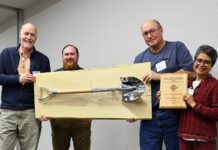The Ohio Wildlife Council is reviewing a proposal to add the American bullfrog and the green frog to the list of Class A aquaculture species. This would allow licensed aquaculture facilities to breed, raise and sell these two species of frogs.
Brian Banbury, executive administrator of information and education for the ODNR Division of Wildlife, says the proposal is less about commercial enterprise and more about helping to save tadpoles.
Outdoor ponds
Banbury, who taught Herpetology at Hocking College and spent 20 years working as a wildlife officer and investigator, explained that “aquaculture” means fish farming — not just with tanks in buildings, but mostly with outdoor ponds where fish are raised and harvested under controlled conditions.
American bullfrogs and green frogs naturally breed in those ponds, he said. Other types of frogs, not so much. Their tadpoles aren’t fast enough to evade fish, so they prefer marshes and puddles in the woods. That lessens the competition for the bullfrogs and green frogs. But the nature of aquaculture operations makes the fish farm ponds pretty lethal to their offspring, at least under the current law.
Bullfrog tadpoles take two years to develop into adults. When a pond is drained or fish are netted, they are unable to jump onshore and escape. While green frog tadpoles only take one year to develop, the pond could be drained or fish netted more than once in that time. Because they can’t be sold, the tadpoles are either left on dry land or tossed into whatever water is left. Most don’t survive.
“It’s really to solve the problem of what to do with all these tadpoles,” Banbury said of the proposed regulation.
Under the new rules, licensed aquaculture facilities could sell the tadpoles “to pet stores, water garden stores and private pond owners,” he said. “We’d rather see them go into another suitable body of water to thrive instead of wasting the resources.”
The eight-member Ohio Wildlife Council must approve all rules and regulations enforced by the Division of Wildlife. But unlike most other state agencies, revising those regulations is a constant process.
“Because we’re dealing with living critters, we have to make changes and amendments to those regulations every year, sometimes several times a year, depending on both wildlife populations and human dynamics,” Banbury said.
The council will vote on this and other proposals at their regular meeting Oct. 7. But until then, they are seeking public input, including at a statewide hearing Sept. 17. Comments can also be sent by email through the Division of Wildlife website, wildohio.gov.
If the new regulations are approved, they would go into effect Jan. 1. And that might be good timing for the new rules. With more people staying around home — or seeking outdoor adventures — due to COVID-19 restrictions, many pond owners have decided to “fix them up and improve habitat,” Banbury said.
Bullfrogs can live upward of 20 years, he said, so they’ll use that habitat for a long time. They eat bugs — a lot of bugs — and some small fish. They’ve been known to grab mice, shrews or other small mammals that happen by. “They can eat anything that fits in their mouth,” he said.
Meanwhile, frogs are an important food source for raccoons, snakes, possum, minks, weasels, even other frogs. They’re also a food source for people, and there are folks who go frog gigging a couple of times a year, hoping to get frog legs for the deep fryer.
Bullfrogs and green frogs are the only frogs that can be legally harvested in Ohio. Both have seasons and limits. But there’s really not much demand for Ohio-grown frog legs in grocery stores, Banbury said. At least not compared to the South, where the growing season is longer and produces bigger frogs.
So again, the new regulations would be less about profit and more about “solving a problem in the aquaculture industry. It allows sustainable use of a renewable resource,” he said.
There are 12 species of frogs and three species of toads in Ohio. Both are amphibians, meaning “dual life,” which refers to the fact that they have both a water phase and a land phase. They start as eggs laid in the water, then hatch and become tadpoles. They move to land as adults, but return to the water to breed.
Unlike their toad cousins, frogs can’t stray too far from water. That’s because part of their breathing is done through the skin, which must be kept moist. Bullfrogs and green frogs especially must keep their skin moist, so they don’t venture far from the pond. Toads and some other types of frogs have a little more leeway, Banbury said.
The Ohio Wildlife Council is also considering three other proposals that they will vote on Oct. 7. One is to remove the daily bag limit for channel catfish in public waters of less than 700 acres. Another would raise the daily bag limit to six for walleye in the Sandusky River and Sandusky Bay areas. It was lowered to four in 2019 to help spawning stock recover from the removal of the Ballville Dam.
Yet another proposal would allow carcasses and parts of deer, elk, moose and other “cervids” to be brought into Ohio from other states as long as they are taken to an authorized meat processor or taxidermist within 24 hours. The Division of Wildlife would then provide processors and taxidermists with training on handling and disposal of these animals to prevent the spread of chronic wasting disease.
A complete list of proposed regulations is available on wildohio.gov. Again, you can comment through the website, or call 614-265-6304 at least two days in advance if you wish to attend the Sept. 17 public hearing.
Banbury thinks the new regulation governing frogs would be well received. Turns out frogs are rather popular with Ohioans.
“Everybody’s held one as a kid, everybody’s read children’s books about kissing one,” he said. “They’re one of our most well-loved critters.”













